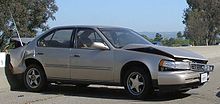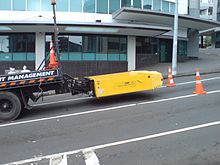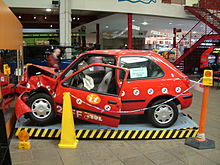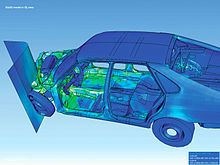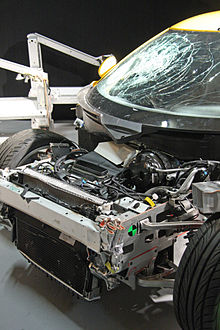- Crumple zone
-
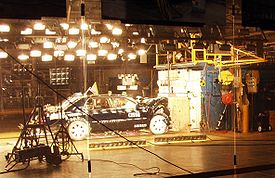 A crash test illustrates how a crumple zone absorbs energy from an impact.
A crash test illustrates how a crumple zone absorbs energy from an impact.
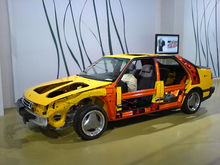 Cross section to show the different strength of the metal in a Saab 9000. The safety cell is in stronger metal (red) compared to the crumple zones (yellow).
Cross section to show the different strength of the metal in a Saab 9000. The safety cell is in stronger metal (red) compared to the crumple zones (yellow).
The crumple zone is a structural feature mainly of automobiles. Crumple zones have also been incorporated into railcars in recent years.[1][2][3] They are designed to absorb the energy from the impact during an accident by controlled deformation. This energy is much higher than is commonly recognized. The severity of a collision with a pole or tree at 60 km/h is similar to driving over a 10 meter sheer drop and crashing onto a hard surface.[4] Typically, crumple zones are located in the front part of the vehicle, in order to absorb the impact of a head-on collision, though they may be found on other parts of the vehicle as well. According to a British Motor Insurance Repair Research Centre study of where on the vehicle impact damage occurs: 65% were front impacts, 25% rear impacts, 5% left side, and 5% right side.[5] Some racing cars use aluminium or composite/carbon fiber honeycomb to form an impact attenuator that dissipate crash energy using a much smaller volume and lower weight than road car crumple zones.[6] Impact attenuators have also been introduced on highway maintenance vehicles in some countries.
An early example of the crumple zone concept was used by the Mercedes-Benz engineer Béla Barényi on the 1959 Mercedes-Benz "Fintail".[7] This innovation was first patented by Mercedes-Benz in the early 1950s. The patent 854157, granted in 1952, describes the decisive feature of passive safety. Barényi questioned the opinion prevailing till then, that a safe car had to be rigid. He divided the car body into three sections: the rigid non-deforming passenger compartment and the crumple zones in the front and the rear. They are designed to absorb the energy of an impact (kinetic energy) by deformation during collision.[8]
On September 10, 2009, ABC News 'Good Morning America' and 'World News' showed a U.S. Insurance Institute of Highway Safety crash test of a 2009 Chevrolet Malibu in an offset head-on collision with a 1959 Chevrolet Bel Air sedan. It dramatically demonstrated the effectiveness of modern car safety design, over 1950s design, particularly of rigid passenger safety cells and crumple zones.[9] [10]
Contents
Function
 VW Vento / Jetta activated front crumple zone.[11]
VW Vento / Jetta activated front crumple zone.[11]
 A Toyota Camry after a front impact with a tree. Airbags were deployed.
A Toyota Camry after a front impact with a tree. Airbags were deployed.
Crumple zones work by managing crash energy, absorbing it within the outer parts of the vehicle, rather than being directly transmitted to the occupants, while also preventing intrusion into or deformation of the passenger cabin. This better protects car occupants against injury. This is achieved by controlled weakening of sacrificial outer parts of the car, while strengthening and increasing the rigidity of the inner part of the body of the car, making the passenger cabin into a 'safety cell', by using more reinforcing beams and higher strength steels. Impact energy that does reach the 'safety cell', is spread over as wide an area as possible to reduce its deformation. Volvo introduced the side crumple zone, with the introduction of the SIPS (Side Impact Protection System) in the early 1990s.
When a vehicle and all its contents, including passengers and luggage are travelling at speed, they have inertia which means that they will want to continue forward with that direction and speed (Newton's first law of motion).[12] In the event of a sudden deceleration of a rigid framed vehicle due to impact, unrestrained vehicle contents will continue forwards at their previous speed due to inertia, and impact the vehicle interior, with a force equivalent to many times their normal weight due to gravity. The purpose of crumple zones is to slow down the collision and to absorb energy, to reduce the difference in speeds between the vehicle and its occupants.
Seatbelts restrain the passengers so they don't fly through the windshield, and are in the correct position for the airbag and also spread the loading of impact on the body. Seat belts also absorb passenger inertial energy by being designed to stretch during an impact, again to reduce the speed differential between the passenger's body and their vehicle interior. In short: A passenger whose body is decelerated more slowly due to the crumple zone (and other devices) over a longer time, survives much more often than a passenger whose body indirectly impacts a hard, undamaged metal car body which has come to a halt nearly instantaneously. It is like the difference between slamming someone into a wall headfirst (fracturing their skull) and shoulder-first (bruising their flesh slightly) is that the arm, being softer, has tens of times longer to slow its speed, yielding a little at a time, than the hard skull, which isn't in contact with the wall until it has to deal with extremely high pressures.
The final impact after a passenger's body hits the car interior, airbag or seat belts, is that of the internal organs hitting the ribcage or skull, due to their inertia. The force of this impact is the way through which many car crashes cause disabling or life threatening injury. Other ways are skeletal damage and blood loss. The sequence of energy dissipating and speed reducing technologies - crumple zone - seat belt - airbags - padded interior, are designed to work together as a system, to reduce the force of the impact on the outside of the passengers body and the final impact of organs inside the body.
A common misconception about crumple zones is that they reduce safety by allowing the vehicle's body to collapse, allowing the crushing of the vehicle occupants. In fact, crumple zones are typically located in front and behind of the main body (though side impact absorption systems are starting to be introduced), of the car (which forms a rigid 'safety cell'), compacting within the space of the engine compartment or boot/trunk. The marked improvement over the past two decades in high speed crash test results and real-life accidents also belies any such fears. Modern vehicles using what are commonly termed 'crumple zones', provide far superior protection for their occupants, in severe tests against other vehicles with crumple zones and solid static objects, than older models or SUVs, that use a separate chassis frame and have no crumple zones. They do tend to come off worse when involved in accidents with SUVs without crumple zones, because most of the energy of the impact is absorbed by the vehicle with the crumple zone. Another problem is 'impact incompatibility' where the 'hard points' of the end of chassis rails of SUVs are higher than the 'hard points' of cars causing the SUV to 'override' the engine compartment of the car.[11] In order to tackle this problem recent Volvo SUV/off-roaders incorporate structures below the front bumper designed to engage lower height car crumple zones.
Computer Modelled Crash Simulation
In the early 1980s, using technology developed for the aerospace and nuclear industries, German car makers started complex computer crash simulation studies, using finite element methods simulating the crash behaviour of individual car body components, component assemblies, and quarter and half cars at the body in white(BIW) stage. These experiments culminated in a joint project by the Forschungsgemeinschaft Automobil-Technik (FAT), a conglomeration of all seven German car makers (Audi, BMW, Ford, Mercedes-Benz, Opel (GM), Porsche, and Volkswagen), which tested the applicability of two emerging commercial crash simulation codes. These simulation codes recreated a frontal impact of a full passenger car structure (Haug 1986) and they ran to completion on a computer overnight. Now that turn-around time between two consecutive job-submissions (computer runs) did not exceed one day, engineers were able to make efficient and progressive improvements of the crash behaviour of the analyzed car body structure. The drive for improved crash worthiness in Europe has accelerated from the 1990s onwards, with the 1997 advent of Euro NCAP, with the involvement of Formula 1 expertise.
The 2004 Pininfarina Nido Experimental Safety Vehicle locates crumple zones inside the Survival Cell. Those interior crumple zones decelerate a sled-mounted survival cell.[12]
See also
- Automobile safety
- Crash test
- Crash simulation
- Finite element method
- Guard rail#Automotive safety
- Crash barrier
- Impact attenuator
References
- ^ November 6, 2003 Paul Dvorak (2003-11-06). "Will the crash zone crumple? FEA tells". Machine Design. http://machinedesign.com/article/will-the-crash-zone-crumple-fea-tells-1106. Retrieved 2011-09-23.
- ^ http://www.inds.co.uk/education/wdss/Crumple_zones.pdf
- ^ November 6, 2003 Paul Dvorak (2003-11-06). "Will the crash zone crumple? FEA tells". Machine Design. http://machinedesign.com/article/will-the-crash-zone-crumple-fea-tells-1106. Retrieved 2011-11-18.
- ^ [1][dead link]
- ^ A. Robinson, W.A. Livesey (2006). The Repair of Vehicle Bodies P.406. Butterworth-Heinemann. ISBN 978-0-75-066753-1.
- ^ Grabianowski, Ed (2008-08-11). "HowStuffWorks "How Crumple Zones Work"". Auto.howstuffworks.com. http://auto.howstuffworks.com/car-driving-safety/safety-regulatory-devices/crumple-zone.htm. Retrieved 2011-09-23.
- ^ "motoring.independent.co.uk". motoring.independent.co.uk. 2006-01-24. http://motoring.independent.co.uk/features/article340543.ece. Retrieved 2011-11-18.
- ^ "Howstuffworks". Howstuffworks. http://www.howstuffworks.com/framed.htm?parent=crumple-zone.htm&url=http://www.dpma.de/ponline/erfindergalerie/e_bio_barenyi.html. Retrieved 2011-09-23.
- ^ Stark, Lisa (2009-09-10). "Highway Safety Exclusive: Car Crashes, Travel Deaths Prevented by Technology - ABC News". Abcnews.go.com. http://abcnews.go.com/Travel/technology-reduces-severity-car-crashes-fatalities-injuries/story?id=8523234&page=1. Retrieved 2011-09-23.
- ^ Neff, John. "Pics Aplenty: IIHS reveals before and after of Malibu/Bel Air crash". Autoblog.com. http://www.autoblog.com/2009/09/26/pics-aplenty-iihs-reveals-before-and-after-of-malibu-bel-air-cr. Retrieved 2011-09-23.
- ^ a b Wenzel, T.; Ross, M. (2003) (PDF). Are SUVs Safer than Cars? An Analysis of Risk by Vehicle Type and Model. Transportation Research Board. http://eetd.lbl.gov/ea/teepa/pdf/TRB_Safety_1-03.pdf. Retrieved 2008-03-09.
- ^ a b "How Crumple Zones Work". autoevolution. http://www.autoevolution.com/news/how-crumple-zones-work-7112.html. Retrieved 2011-09-23.
External links
- Before and after crash between 1959 Bel Air and 2009 Malibu
- Crumple Zones in Automobiles
- Crumple Zones(How Do Crumple Zones Work)
Categories:- Automotive safety technologies
Wikimedia Foundation. 2010.


